The No 3rd Runway Coalition, of which TAG is an active member, gave further written evidence to the Transport Committee of the House of Commons following their oral evidence. This is now published on the Transport Committee’s website. The staggering fact is that contrary to the Government’s claim in the National Policy Statement, but taking the Government’s own figures, some 2.2 million people and possibly up to 3 million people will experience more noise and over half a million people will receive double the number of overflights should the National Policy Statement be approved and a third runway at Heathrow built. Detailed reasons are given in the written evidence. The Government’s claims in the NPS are quite simply wrong and the sooner they admit it the better. Heathrow already affects more people with noise than any other airport in the World. The full text of the evidence is reproduced below:
No Third Runway Coalition-supplementary written evidence (NPS0093)
Summary
- The NPS states that no more than an extra 92,700 people will be significantly affected by noise (i.e. falling within the 54 dBLAeq contour) in 2030 if the Heathrow NWR scheme is developed. This is based on a “minimise total” scenario, assuming concentrated flight paths to reduce the measurable number of people impacted.
- Yet the NPS fails to represent the CAA’s economic analysis, which uses the DfT’s webTAG appraisal model (which was made available on 31 January 2018 following a Freedom of Information request). This shows that more than 420,000 people, who are already impacted over the 54 dB LAeq ‘significance threshold’, will receive 3 dB of extra noise – equivalent to doubling of the number of flights experienced daily.
- Moreover, in this study’s Noise Workbook a summary of the monetised health costs and quantitative results states that 972,957 households will incur an increase in daytime noise at the forecast year (2060 – by which time it is assumed in the NPS quieter planes will have been introduced). This would mean that, based on the CAA’s average dwelling occupancy, by that time 2,238,000 people will experience increased noise with a third runway. During the early years after opening the effects will be even worse.
- These figures together with the implications of embedding forever a six-and-a-half-hour night (ending at 5.30 am), a lack of research into the impact of respite (which will be halved) and the introduction of super concentrated routes (using PBN) are not highlighted or addressed by the NPS. Flight path strategies have not been considered; no one knows who will be affected or by how much.
- This is a totally unacceptable basis for engaging with the public or asking Parliament to make a decision of such significance. It is symptomatic of a lack of check and balance in aviation governance, which should be reviewed in the light of the NPS.
Introduction
- This submission reflects information arising from the TSC’s oral hearings where it received evidence from Heathrow Airport, the Secretary of State for Transport (and his officials), the CAA and airline representatives on 5, 7 and 20 February.
- It also assesses evidence that has come to light from:
- The webTAG workbook used by the CAA to calculate noise impacts reflected in the NPS together with its assumptions regarding fleet transition.
- Matters discussed at the Heathrow Community Noise Forum Working Group Meetings on 13 and 15 February 2018 relating to Heathrow’s draft Noise Action Plan, the CAA’s SoNA and the airport’s noise contour reports.
Government Policy on Aviation
- The Aviation Policy Framework 2013 sets out high level objectives for aviation including addressing a range of local environmental effects. These include:
- ‘Aiming to limit and, where possible, reduce the number of people significantly affected by aviation noise’.
- It should be borne in mind that Heathrow already accounts for 27% of all people within Europe considered to be adversely impacted by noise from aviation (the UK accounts for approximately 40%). The present noise impacted population from Heathrow is equivalent to Frankfurt, Paris Orly, Paris CdG, Brussels, Amsterdam, Madrid, Rome and Munich combined, notwithstanding this impact is caused by many fewer flights;
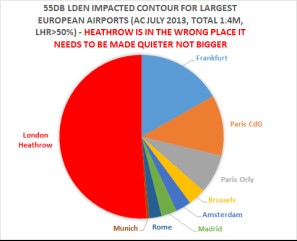
- The diagrams below indicate the extent of Heathrow’s noise footprint, which is dominant and excessive on a UK basis as well;
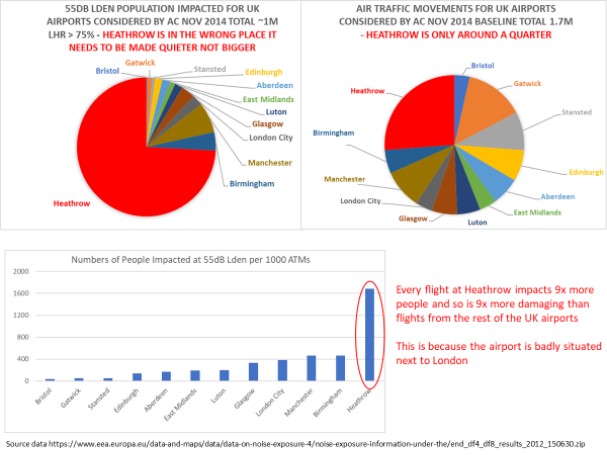
Lack of balance or adequate governance
- At the TSC hearing on 20 February, Andrew Haines, the CAA’s Chief Executive stated that his organisation is not responsible for aviation noise. This is notwithstanding the CAA produced all the noise analysis used in the preparation of the Airports Commission’s (AC) work and the NPS.
- This raises the question if the CAA is not responsible, and the DfT is clearly leading the push to see Heathrow expanded (and therefore conflicted), who is responsible for protecting the public from the impact of aviation noise(which is recognised to an increasing degree to cause major health impacts)?
- Given this lack of accountability in governance, it is hardly surprising the noise impact assessments in both the AC’s work and the NPS are so deficient. From the communities’ perspective, in the interests of promoting Heathrow’s expansion it is evident there is a culture within the DfT, the CAA and the industry to downplay – some would say conceal – the real impacts of aviation, particularly in relation to noise, the most obvious manifestation of environmental damage caused by the industry (but not the only one).
- Such a lack of check and balance could hardly be more serious given the NPS’s proposal to develop an extension to Heathrow, in its own right the size of Gatwick, involving 54% increase in flight numbers in the middle of one of the most densely populated areas in Europe.
The true scale of the impact of developing a third runway
- The AC originally advised that expansion of Heathrow could be achieved without increasing the number of people significantly impacted by aviation noise. It considered this could be achieved by a combination of quieter planes (fleet transition over 25 years) and alternative flight path strategies. In reaching this conclusion it worked closely with the CAA, which was responsible for producing and confirming the noise assessment, using its ANCON model.
- The AC considered three flight path scenarios; minimise total, minimise newly affected and respite. All its modelling was undertaken based on long term overall (mixed mode) averages – 57 dB LAeqand N>70 dBLAmax being the key indicators.
- The use of long term measures (both average noise and noise event contours) amalgamate periods when areas are not overflown (for example due to airport operational mode or respite) to hide the most intensive and intrusive impacts of aviation on everyday life.
- The NPS’s assessment is also based solely on ANCON, modelled by the CAA. The NPS assumes a faster take up of spare capacity, with the new runway at full capacity by 2028, two years after opening. Despite WHO advice, the findings of the Australian Senate Select Committee and other more recent studies the analysis in the NPS is based solely on long term average LAeq metric analysis.
- The NPS does reflect updated DfT policy to reflect significant annoyance at 54, rather than 57 dB LAeq. However, critically the NPS does not follow the precedent of the AC and include noise event analysis.This is despite the fact that, following consultation, in 2017 the DfT itself adopted new key supplementary metrics into UK aviation policy (for all major airspace changes), including numbers of single noise event (N>65dB) and single mode (easterly or westerly) analysis.
- Also, critically, the NPS also only considered one flight path scenario; minimise total, rather than the three used by the AC.
- Mr Haines was asked about this during oral examination and responded saying that he was satisfied, based on the updated analysis and the AC work, that sufficient analysis had been undertaken to evaluate and understand the effects of a third runway as outlined in the NPS. This does not accord with the agreed basis of the CAA’s commission or reflect the concerns of his own specialists.
- As discovered through a Freedom of Information request, the original instruction from the DfT was for the CAA to model all three flight path scenarios used by the AC – which had significantly different outcomes.
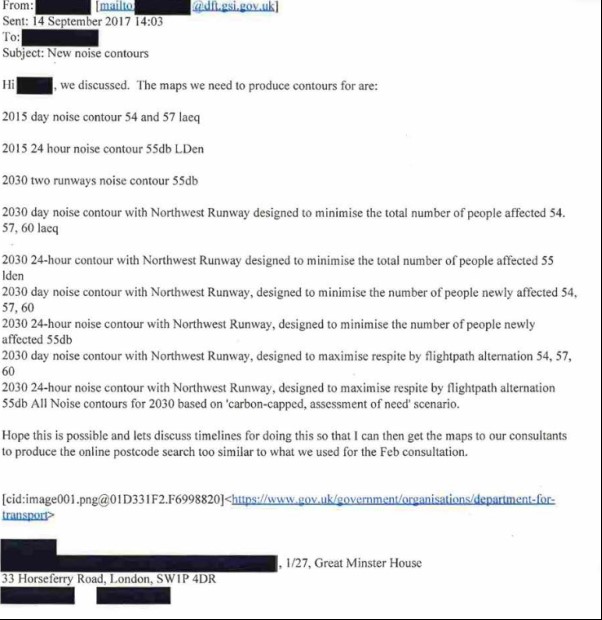
24. An FOI response reveals the issue of flight paths was discussed by the Future Airspace Strategy (FAS) steering group chaired by the CAA. A key email from the CAA to the DfT dated 10 May 2017is reproduced below;
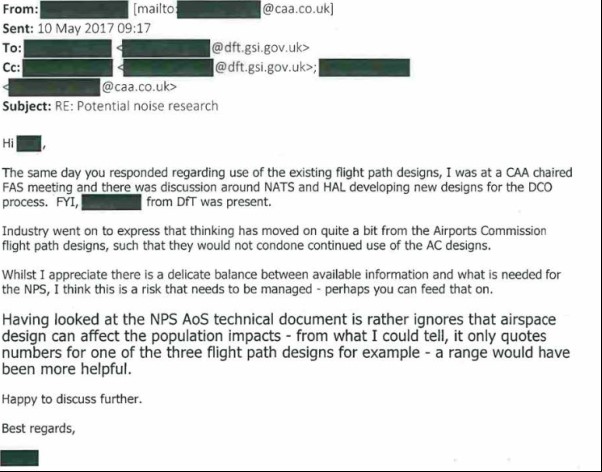
- In the light of the oral evidence hearing on 20 [February] 2018, these emails and the approach adopted in the NPS require full explanation and justification from the CAA.
NPS hiding the real impacts
- Within the NPS the DfT accepts, for the first time, that the number of people considered to be significantly affected by aviation noise would increase with Heathrow expansion. It states 92,700 additional people would fall within the 54 dB LAeqcontour by 2030.
- As will be seen below this is a vast underestimate of the impact of developing a third runway.
- The CAA was responsible for producing the economic analysis in the NPS using the DfT’s webTAG appraisal model (populating it with assumed numbers impacted). It is only through examining webTAG in detail that the full scale of the impacts on the population of London and the South-East becomes apparent. The webTAG Noise Workbook -https://www.whatdotheyknow.com/request/aviation_policy_framework_metric_2#incoming-1104762 – was only made available to us on 31 January 2018 following a Freedom of Information request.
- The Noise Workbook – Worksheet 1 (reproduced below) – provides a summary of the monetised health costs and critically the Quantitative Results. This states that 972,957 households will incur an increase in daytime noise at the forecast year.
- Based on the average dwelling occupancy rate used by the CAA this indicates 2,238,000 people will experience increased daytime noise with a third runway. However, this does not tell the whole story. The ‘forecast year’ used for the webTAG model is 2060 – at this time the NPS assumes the fleet will be transitioned to ‘new generation’ modern quieter aircraft. By the time the new runway opens in 2026 and reaches full capacity by 2028 there will not have been enough time for all the quieter planes to have come in. On this basis the number of people adversely affected is likely to be significantly higher and could exceed 3,000,000 within two years of the scheme opening.
- It is also important to note that whilst in net terms this represents an increase of 299,173 households who will be impacted by extra noise, this is equivalent to 688,098 people in net terms who will be impacted with more noise.
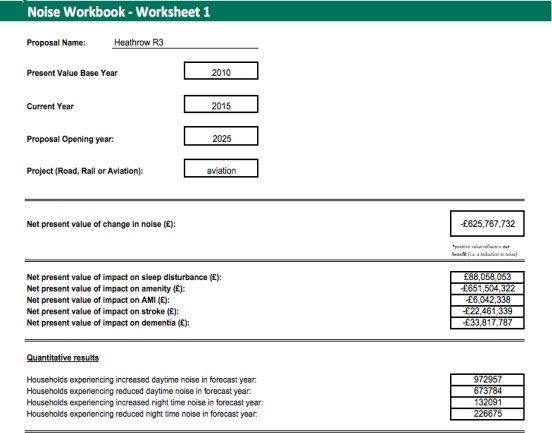
- The sheer scale of these impacts is astonishing. This has huge implications but is not referred or alluded to in the NPS, its AOS or its Noise Topic Appendix, A-4.
- Even this does not tell the full story.
- This analysis is based on only the ‘Minimise Total’ flight path scenario. Other scenarios, which will be necessary to mitigate the extreme effects, especially in the context of PBN concentration, will be required.
- There are also systemic flaws in the option appraisal on which the analysis has been undertaken particularly in relation to assessing the base case ‘Do Minimum’ position, as well as highly optimistic assumptions concerning the rate of fleet transition. We highlight in subsequent sections of this submission the extent to which we consider the NPS does not represent the real position.
- But even this does not reveal the full impact of the expansion proposed in the NPS.
- To understand the true human cost of the NPS it is necessary to examine the webTAG Noise Workbook in more detail.
- The webTAG noise monetisation assessment is based on changes to the populationfrom the additional overflight arising from implementation of the NPS (NB not overall cost of the airport as we have pointed out in our previous submission).
- Through the Workbook’s detailed analysis of the numbers of people in each dB LAeqband above the DfT 54 dB LAeq threshold level (i.e. the population considered to be significantly annoyed) for 2030, it can be seen that 140,853 (net) people will experience an additional 3dB LAeq of noise – which is equivalent of a doubling of the number of flights (possibly even more when the impact of the modelling assumptions of quieter planes is considered).
- Unfortunately, even this does not reveal the true extent of the impact as the net figure arises from a combination of winners and losers. The grossnumber of people who are already significantly impacted by 54 dBLAeqbut who will experience a doubling of overflights is predicted by webTAG to be 419,803. For reasons summarised above (especially different flight path scenarios) even this figure is likely to be a significant underestimate.
- In terms of gross numbers impacted, after allowing for more realistic flight path scenarios, it is not unreasonable to anticipate that by the time the scheme is opened and reaches capacity in 2028, over 3 million people will experience more noise and over half a million people will receive double the number of overflights should the NPS be approved.
- It is truly extraordinary that the real level of impact is buried in the fine print of an extremely technical supporting document – provided in response to a FOI request – rather than being presented clearly to MPs and the public in the NPS.
Winners and losers (mainly losers)
- The above section highlights net and gross impacts, hitherto not identified in the NPS.
- With regard to the net figures, it may be possible to say that some people will receive some benefit. However, this is not the way people who are adversely impacted will see things and the NPS’s analysis needs to be set in the following context:
- Those experiencing the adverse changes are likely to become very upset indeed. For very many their quality of life will be devastated through no fault of their own. A third runway at Heathrow will provoke a furious public reaction, even more so than Sydney or Frankfurt. This should be highlighted toMembers of Parliament when they are asked to consider the NPS.
- Due to the lack of flight path information, and the lack of consideration of alternative flight path strategies, actually no one knows who will be affected nor by how much.This is a totally unsatisfactory basis to consult the public, let alone for Parliament to make a decision.
- For the reasons stated above the NPS’s analysis is likely to understate by a vast amount the scale of the problem and the numbers adversely affected.
- The proposed mitigations will not work. A partial night flight ban (something still resisted by the airlines) with operations commencing each day at 5.30 am will be embedded into the lives of a vast number of people, effectively forever.For those living under departures this will actually be worse than the current situation as they will experience a reduced night period. The face of London and the home counties will change; the effects will be irreversible.
- Respite will be reduced from one half a day to one third.No research on the impact of this loss of respite has been concluded. Heathrow commenced work on this as long ago as 2014 but the analysis has not been finished and no meaningful conclusions have been reached. It is not even known whether the implied respite periods will be technically feasible.
- The position will be exacerbated to an even greater degree by extremely concentrated flight paths introduced with Performance Based Navigation (PBN). These have been described by the CAA as ‘noise sewers’. At a national level the use of PBN is likely to be very controversial – there are many cases across the world where PBN has led to mass protests and successful legal challenges. To expand the numbers of flights over London by 54% involving PBN would be an extreme risk – a colossal number of people will be affected.Neither the DfT, the CAA nor Heathrow have published research on the implications of introducing PBN over densely populated areas. To proceed with expansion of Heathrow given current knowledge would be reckless.
- The following sections consider more detailed aspects of the noise modelling undertaken by the CAA on the DfT’s behalf.
Alternative flight path scenarios – the implications
- As noted, unlike the Airports Commission (AC) only one flight path scenario is considered in the NPS, which is based solely on the Minimise Total scenario. This is not what Heathrow and the DfT have said they are proposing – they have committed to considering alternative flight path strategies.
- The potential implications of using alternative flight path approaches can be deduced from the AC’s analysis.
- The AC predicted for 2030 and a 16-hour day and 54 dB LAeq, the minimise total (T) scenario contour would include 456,200 people, whereas minimise newly affected (N) would impact 566,900.
- This represents an increase of 24%.On this basis, the NPS estimate of 653,900 for T would be expected to increase to more than 800,000 for the N scenario, had it been modelled. Compared to the Do Minimum base case, this would represent a total increase of circa 250,000 newly impacted people at 54 dB LAeq on an equivalent basis.
- Whilst this calculation is of necessity an interpretation (as the work has not been done, or at least shown, in the NPS), despite the statement of Mr Haines at the oral hearing, it demonstrates how critical flight path scenarios are to calculation of the impacts.
- As explained, the NPS does not consider different flight path approaches although we know from FOI that this was the instruction by the DfT to the CAA. We also know from correspondence between the DfT and CAA that the industry no longer supports the AC’s original assumed scenarios. In addition, the CAA recorded concern regarding relying only on the minimise total scenario in its email dated 10 May 2017.
- As highlighted in our earlier submissions to the TSC, the Do Minimum (DM) scenario is not optimised in the way the change (third runway) option is. In order to undertake a proper analysis with a level playing field, the base case should have assumed flight paths could be varied, included deeper landings into the airport and steeper descents introduced to reduce impacts, as this can occur without expansion.
- It should be noted that particularly for the DM case the number of assumed ATMs exceeds the current legal limit of 480,000 set for Heathrow. The assumptions used in webTAG are reproduced below.

- The above factors are indicative of a biased and unbalanced approach in the option appraisal in order to support the case for a third runway.
- The noise projections for the AC and NPS analyses are so much at variance in terms of numbers impacted, assumptions made and conclusions reached, that neither can be treated as a robust or reliable evidence base for moving forward.
- This is especially important as the NPS claims primacy in terms of addressing noise impacts and the development of an extended airport will have irreversible effects over a very wide and highly populated area.
Fleet Mix Assumptions
- The predicted noise – and environmental impacts – assessed by both the AC and NPS is directly dependent on three key factors:
- Assumed ATM numbers
- Rate of transition of the fleet
- Assumed benefits of ‘new generation’ aircraft
- It will be noted the NPS is now predicated on an assumed 15-year fleet transition period. The AC’s analysis was based on a 25-year turnover. No justification or explanation of the accelerated rate of change has been provided. However, both sets of assumptions and the associated impact on noise appear extremely optimistic.
- Heathrow states in its ‘Airspace Principles Consultation Document’ that by the time of the new runway opening in 2026, 90% of its fleet will be quieter ‘new generation’ planes. This was queried at the HCNF WG1on 13 February 2018 as it appears extremely ambitious. The meeting was informed that 60% of these new planes were already operating out of Heathrow.
- On this basis, many of the benefits of a quieter fleet should already be evident. In addition, Heathrow’s response implies that a change of 30% to new generation aircraft will occur over the next 8-year period to 2026. This optimistic rate of change is equivalent to a fleet lifecycle transition of 27 rather than 15 years as assumed by the NPS.
- Recently, significant doubt has arisen regarding the rate of take up of certain ‘new generation’ aircraft types – which are critical to achieving the noise benefits assumed in the NPS.
- There is no CAA published data on the A320neo or 737-max quieter narrow-bodied planes types – the extent of noise reduction assumptions needs to be open and validated. However, the fleet mix has the fundamental problem that new 4 engine planes will not be available. As already noted in previous TSC submissions the industry is not buying 747-8s for passenger use – they are not economic and the A380neo is not planned – Airbus are only just managing to keep production going on the A380 by pressurising Emirates to buy a few as reported recently. These planes are used in the LHR Hub models (although only 10-20% of ATMs they are the noisiest planes) but will either have to be replaced by 787 dreamliner types carrying less people so delivering less economic value to the UK or make continued use of the existing noisier A380 making the future noise footprint larger.
- The assumed improvements in the noise environment predicted in the NPS do not look reliable or credible, particularly when it is considered that the majority of the existing fleet is already ‘new generation’ and there will only be 30% fleet transition by the time a new runway would be opened in 2026.
- As noted in our previous submissions the early years (2026-2030) will be the most critical in terms of public reaction to this scheme. Impacted populations will not be interested in possible future improvements in 2040 or 2050 at that time.
Other important developments – significant errors found in CAA noise modelling requiring work to be repeated and reports reissued
- We have highlighted errors in CAA noise modelling to Heathrow in our previous submissions to the TSC.
- In supplementary written evidence to the TSC (submission 77629) Heathrow has finally accepted that the CAA’s ANCON model has flaws;
‘2.20 Heathrow is aware of under prediction of LAmax data at some locations when using the latest Civil Aviation Authority (CAA) Noise Contour (ANCON) model. In order to address this issue, the CAA is now introducing formal Lmax modelling and measurement validation into its model validation processes, acknowledging the limitations associated with LAmax modelling.’
- In the recent Heathrow Community Noise Forum working group meeting on 15 February 2018 the CAA reported verbally that due to poor noise modelling the population covered by N> contours will increase by 25-38% (HCNF WG2).
- It was reported that the CAA will now be reissuing 2016 and 2017 noise contours and updating its important Survey of Noise Attitudes (SONA) report. We asked if the AC work would be repeated but got no clear answer. This seems vital given the evidence provided to the TSC.
Significance of CAA noise modelling errors
- Oral evidence given to the TSC by Philip Graham, a former member of the Airports Commission, accepts the importance of noise events.
‘We did another thing that differed somewhat from past practice on noise calculations. One of the most significant challenges made to us was that the standard approach to calculating noise, the so called LAeq – I cannot remember what it stands for, but it is an average noise level across a period of the day – did not reflect the way in which many people experience noise. What they cared about was not what the average level was once you had flattened everything, but how many times a loud plane was going to fly over their head, so we incorporated in our analysis an additional methodology that had been developed in Australia for what they call number above contours. Rather than trying to create an average noise level, those identify the communities and properties that are overflown more than a certain number of times by an aircraft hitting a particular noise threshold. Having done that work, we found that the contours were still broadly similar, so it did not change the picture significantly, but it did at least allow us to check that we were not missing something in the way we thought about noise’ (TSC 75211 – Q22).
- The above conclusion is now found to be based on false modelling data. Given the importance the AC attached to the metric, the NPS should now be required to include N>65dB analysis for all flight path options
- A further example of the ANCON models’ underestimate of loudness is shown below. This explains why some residents are complaining about loud planes well away from the airport which have not been predicted and which is especially important for night time noise annoyance contours which are based on N>60dB events which we now know will have been underestimated for many years.

- Technical errors have also been found in SONA, which has undermined the case for using average LAeq metrics rather than N>65dB or N>70dB measures.

74. The assessment of noise impacts should now include all the DfT’s approved metrics and be peer reviewed at each stage with agreed sensitivities included.
Conclusions and Recommendations
- The NPS conceals the real level of noise impacts that will impact a very large area of London and the South-East with a third runway at Heathrow by a huge margin. By the time the airport is fully operational, it is quite likely more than 3 million people will experience more noise and approximately half a million who are already ‘significantly affected’ at 54 dB LAeqwill experience double the number of overflights. The NPS omits entirely to provide information entirely on the numbers of people who will fall within the LOEL 51 dB LAeqcontour, adopted in 2017 by the DfT in Airspace Management Policy.
- The level of impact of a third runway is not made clear at all in the NPS – the above data has been extracted from the CAA’s webTAG analysis only made available to us on 31 January 2018 following a freedom of information request, a long time after the closing date for submissions to the TSC.
- The NPS only appraises the Minimise Total flight path scenario. Based on the AC’s analysis this is likely to lead to a substantial under prediction of noise impacts, once practical flight path options become identified. At this stage, no one knows how many people will be affected, where the impacts will be and how much additional noise there will be over specific locations. This is an unacceptable basis for public consultation or political decision making.
- In addition, the DfT and Heathrow have failed to carry out essential research on health and quality of life impacts particularly arising from concentrated flight paths, respite (the routes which have been considered may not even be technically possible) or embedding a six-and-a-half-hour night period ending at 5.30 am on a vast population. Given that more than three million people will experience increased noise and while considering even those benefitting from some reduction will still be impacted, it is not unreasonable to anticipate expansion of Heathrow could impact adversely the lives of many millions of UK citizens.
- We have identified crucial flaws in the CAA’s noise modelling that require existing contours to be reworked. On the same basis for reasons explained in this submission SoNA should be independently peer reviewed and if necessary the work should be repeated.
- The current situation, epitomised by the NPS, has arisen due to unacceptable governance arrangements for aviation in the UK. The DfT has sought to construct an evidence base to justify expansion of Heathrow rather than independently and impartially assessing all the facts. The regulator, the CAA denies it has responsibility for protecting UK citizens from aviation’s adverse environmental side effects. No one else accepts accountability for this. There is no trust between communities the DfT, the CAA, NATS or Heathrow airport. In future aviation should be overseen by a parliamentary oversight committee with members representing the departments of health, environment, education, treasury, BIS as well as transport.
- Against this background the NPS should be withdrawn pending comprehensive independent review or alternatively rejected entirely.
February 2018
15

Be First to Comment